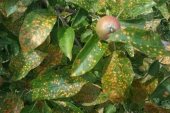posted 6 years ago
I'm pretty aggressive about the rust. The cedars are infected, to the best of my knowledge, once they have manifested the fruiting bodies, beyond the visible infection. Pruning the fruiting bodies is practically worthless. I am ruthlessly culling infected cedars. There are several different rusts: cedar + hawthorn, apple, quince etc. We have almost entirely apple and hawthorn rust here, but you may be different.
The rust is spread for kilometers, I don't think pruning fruiting bodies is likely to be effective. I plant ONLY resistant plants if I can find them, the apple relatives are the (generally) non-natives that the junipers have no resistance to, so I try to help by not planting cultivars that make the problem worse. I am hoping to generate a resistant genetic profile on my property- any fruiting bodies mean the juniper is culled. You sadly have to pick between the native junipers and the non-native apples. The exception is the serviceberry, which is highly affected but also native.
I pruned some serviceberries that were showing rust, but again, it seems futile. I am hoping to get better genetics through selection pressure- resistant "cedars" and resistant serviceberries. I know I am an outlier but resistant eastern red cedars would be a huge contribution, and nature does most of the work. I have promised my seeds to anyone who asks when I get a pretty good selection of naturally resistant trees pollinating each other. So far unfortunately I am up to four mature trees that show natural resistance, and there are other eastern red cedars that may be contributing pollen, they are within a quarter mile and I don't own that property. It is going to take some time... Seeds will be offered here this winter for the eastern redcedar. I will even pay postage. This is a bit of a quest!
Standing on the shoulders of giants. Giants with dirt under their nails








